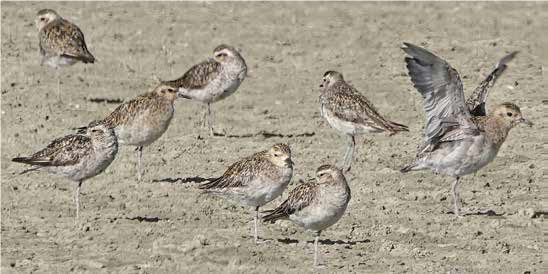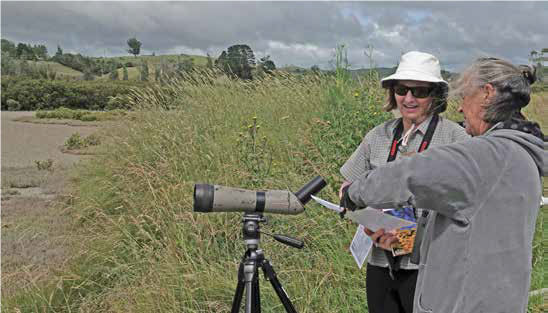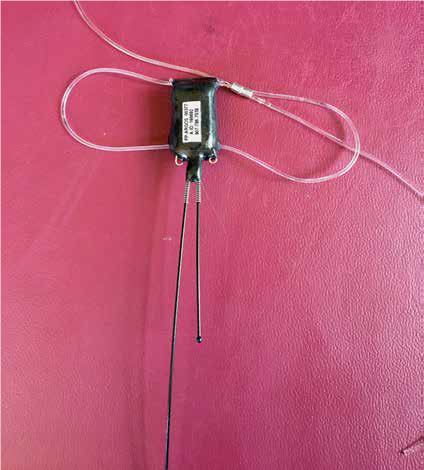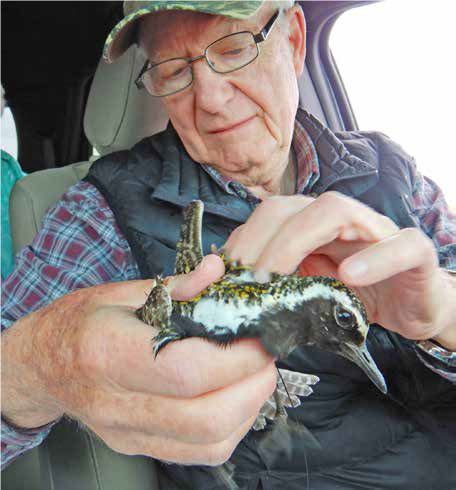18th December 2018
Right now there are around 60 Pacific Golden Plover at the Robert Findlay Wildlife Reserve adjacent to the Shorebird Centre. That’s a good number because in the past 10 years the annual counts for the National Wader Census have recorded an average of 18 birds. (The photo below by Jim Eagles shows a few of them roosting out on the mudflats.) Having that many should make it easier to catch 10 strong, fit birds to carry out satellite tags.

If you’ve never seen a Kuriri now is a good time to do so. Come down to the Shorebird Centre a couple of hours either side of high tide and one of our Summer Shoreguides will usually be able to find a few to show you. If you’d like to take a peek at some of what they get up to, including feeding on worms and hiding in the undergrowth, you can watch this short video.
MONITORING THE BIRDS

We now
have a team of volunteers, led by JoJo Doyle (she’s on the right in the photo
below along with Summer Shoreguide Amanda Hunt) who are watching the plovers
and recording their movements. So far they’ve been spend a lot of time hanging
out in their favourite place of previous years near the start of the boardwalk
from the car park to the hides. They are
also regularly seen on the mudflats well out in front of the Godwit Hide and
now and again they pop up near the mouth of the Pūkorokoro Stream. From time to
time they’ve been visiting a couple of farm paddocks over the road and
sometimes they just disappear. So there’s plenty of work to do. If you’d like
to join monitoring team please contact the Shorebird Centre.
WHAT ABOUT THE SATELLITE TAGS?

Lotek Wireless, a Canadian company, is currently making 10 PinPoint Argus Satellite tags for us (shown in the top photo). These are ultra lightweight tags which, including the harness used to attach them to the birds, weigh just 4g. This is only 2-3% of the body weight of the birds and Dr Wally Johnson, the world expert on Pacific Golden Plover (shown in the bottom photo checking out a bird after removing a tag), has fitted them to hundreds of plovers in the course of many years of research and recorded no ill effects.

Research
like this is very strictly controlled and before going ahead we had to get
authority under the Wildlife Act from the Department of
Conservation and approval under the Animal Welfare Act, which was given by
Massey University’s Animal Ethics Committee. A lot of expertise went into
designing the project and that was provided by Dr Johnson, a research scientist
at Montana State University; New Zealand’s leading shorebird academic,
Associate Professor Phil Battley from Massey University; DOC biodiversity
ranger for Hauraki Mailee Stanbury, Shorebird Centre Manager Keith Woodley and
Banding Committee chair Adrian Riegen. When the tags have been made finished
they will be sent to the Alaska Science Centre to be programmed by Lee Tibbits
who did the same job for the famous Bar-tailed Godwit E7. During the Pacific
Golden Plovers’ migratory flights she will pass us the information as the
satellite tags report their positions.
Visit the Where’s Goldie? main Pacific Golden Plover Project page for more information.

